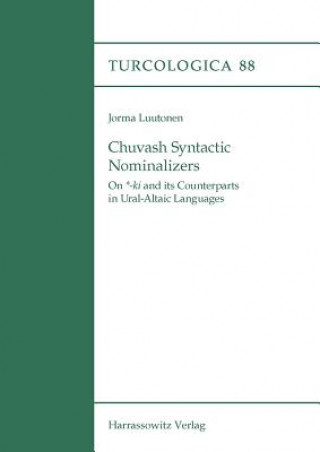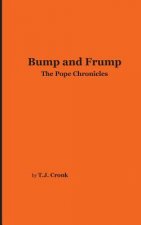
Kód: 12591400
Chuvash Syntactic Nominalizers
Autor Jorma Luutonen
Chuvash has three morphemes, -i, -xi and -sker, which have intrigued scholars for over a century. To some extent, these suffixes resemble derivational endings that produce adjectives, but they also have properties that reach far b ... celý popis
- Jazyk:
 Angličtina
Angličtina - Vazba: Brožovaná
- Počet stran: 133
Nakladatelství: Harrassowitz Verlag, 2011
- Více informací o knize

1456 Kč

Skladem u dodavatele v malém množství
Odesíláme za 10-14 dnů
Potřebujete více kusů?Máte-li zájem o více kusů, prověřte, prosím, nejprve dostupnost titulu na naši zákaznické podpoře.
Přidat mezi přání
Mohlo by se vám také líbit
-

Bibliotheca Somersetensis
1178 Kč -

New Injection Treatment for Impotence
1310 Kč -

Redeeming Love Proclaim: John Rippon and the Baptists
1405 Kč -

The Blessed and Boundless God
266 Kč -

Bump and Frump: The Pope Chronicles
255 Kč -

Bentley
684 Kč -

Archie: 80 Years Of Christmas
266 Kč
Darujte tuto knihu ještě dnes
- Objednejte knihu a zvolte Zaslat jako dárek.
- Obratem obdržíte darovací poukaz na knihu, který můžete ihned předat obdarovanému.
- Knihu zašleme na adresu obdarovaného, o nic se nestaráte.
Více informací o knize Chuvash Syntactic Nominalizers
Nákupem získáte 146 bodů
 Anotace knihy
Anotace knihy
Chuvash has three morphemes, -i, -xi and -sker, which have intrigued scholars for over a century. To some extent, these suffixes resemble derivational endings that produce adjectives, but they also have properties that reach far beyond the sphere of lexical derivation. They are frequently attached to inflectional forms, e.g. case forms and participles, in which case they adopt the role of syntactic converters, changing the syntactic properties of the underlying form. For instance, a case form can be converted into an adjective-like entity, or a participle into a noun-like unit. Synchronically, the basic function of these Chuvash suffixes can be defined as syntactic nominalization. Chuvash Syntactic Nominalizers by Jorma Luutonen contains a critical survey of the earlier research on the subject as well as text-corpus-based quantitative and qualitative analyses of the distribution and functions of the suffixes -i, -xi and -sker in Modern Chuvash literary language. All Chuvash examples are transliterated into Latin characters and provided with morphological glosses. In the historical-comparative part of the book, it is argued that -xi, and partly also -i, can be traced back to the Proto-Turkic *-ki, whose successors are frequently used in the Common Turkic languages, e.g. the Turkish -ki. The book includes separate chapters on Turkish and Tatar, and it also discusses the etymology of *-ki. A survey of the functional counterparts of the Chuvash suffixes in the Mongolic, Tungusic and Uralic languages, as well as in Russian, enables typological and areal linguistic generalizations to be made about the phenomenon.
 Parametry knihy
Parametry knihy
1456 Kč
- Plný název: Chuvash Syntactic Nominalizers
- Podnázev: On *-ki and its Counterparts in Ural-Altaic Languages
- Autor: Jorma Luutonen
- Jazyk:
 Angličtina
Angličtina - Vazba: Brožovaná
- Počet stran: 133
- EAN: 9783447065818
- ISBN: 3447065818
- ID: 12591400
- Nakladatelství: Harrassowitz Verlag
- Hmotnost: 279 g
- Rozměry: 241 × 175 × 17 mm
- Datum vydání: November 2011
Oblíbené z jiného soudku
-

Dune
217 Kč -

Haunting Adeline
621 Kč -

Berserk Deluxe Volume 2
1092 Kč -

White Nights
90 Kč -

Powerless
268 Kč -

Atomic Habits
330 Kč -

Dune Messiah
228 Kč -

Berserk Deluxe Volume 3
1142 Kč -

One Day
220 Kč -

Berserk Deluxe Volume 1
1115 Kč -

Iron Flame
356 Kč -

Surrounded by Idiots
213 Kč -

Harry Potter and the Prisoner of Azkaban (Minalima Edition)
993 Kč -

Gravity Falls Journal 3
443 Kč -

Heaven Official's Blessing: Tian Guan Ci Fu (Novel) Vol. 1
426 Kč -

The Creative Act
550 Kč -

Dune
204 Kč -

Hunting Adeline
642 Kč -

A Little Life
267 Kč -

Children of Dune
230 Kč -

Heaven Official's Blessing: Tian Guan Ci Fu (Novel) Vol. 2
426 Kč -

Bungo Stray Dogs, Vol. 8 (light novel)
379 Kč -

Percy Jackson and the Olympians 5 Book Paperback Boxed Set
944 Kč -

Solo Leveling, Vol. 1
441 Kč -

The Prisoner's Throne
191 Kč -

Court of Thorns and Roses
268 Kč -

Cry Baby Coloring Book
276 Kč -

Fourth Wing
405 Kč -

Icebreaker
199 Kč -

Berserk Deluxe Volume 6
1089 Kč -

Avatar, the Last Airbender: The Kyoshi Novels (Box Set)
833 Kč -

The 48 Laws of Power
601 Kč -

House of Leaves
462 Kč -

Twisted Lies
213 Kč -

Dune Messiah
215 Kč -

No Longer Human
275 Kč -

48 Laws Of Power
331 Kč -

Twisted Games
213 Kč -

Caraval Paperback Boxed Set
903 Kč -

Solo Leveling, Vol. 2
494 Kč -

Open Circuits
908 Kč -

Berserk Deluxe Volume 5
1119 Kč -

Heaven Official's Blessing: Tian Guan Ci Fu (Novel) Vol. 3
356 Kč -

Berserk Deluxe Volume 4
1292 Kč -

Court of Mist and Fury
206 Kč -

SOLO LEVELING V08
436 Kč -

English File Upper Intermediate Multipack A (4th)
487 Kč -

CHAINSAW MAN V14
251 Kč -

Before the Coffee Gets Cold
184 Kč
Osobní odběr Praha, Brno a 12903 dalších
Copyright ©2008-24 nejlevnejsi-knihy.cz Všechna práva vyhrazenaSoukromíCookies


 Vrácení do měsíce
Vrácení do měsíce 571 999 099 (8-15.30h)
571 999 099 (8-15.30h)